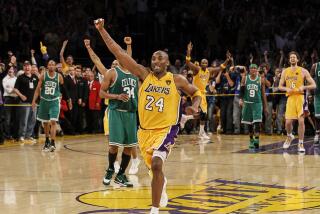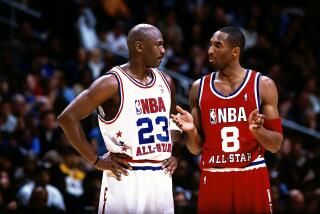Japan’s Kobe Beef Is a Cut Above : Lifestyle: Steaks from the pampered, beer- guzzling cattle cost $100 each in New York restaurant. The U.S. importer says demand is insatiable.
NEW YORK — Sickened by sushi? Turned off by tofu? Not to worry. The latest Japanese food fad is one the meat-and-potatoes crowd will love--if they can afford it, that is.
Darryl Strawberry, Axl Rose and Judd Nelson are some of the names recently on the waiting list at one Manhattan steakhouse that serves juicy, butter-soft Kobe beef.
At $100 a steak, average Americans aren’t exactly stampeding the few spots where the special Japanese beef is available.
“It would be a splurge,” conceded Richard Tarlov, director of product development at Balducci’s, a gourmet market in Greenwich Village. “The cost is very expensive, no matter how you cut it.”
Kobe beef is named for the region of Japan where the best Wagyu cattle used to be concentrated. There, it is used most often in traditional dishes such as shabu-shabu : raw, paper-thin slices waved in hot broth.
Scientists aren’t sure whether the highly marbled beef results from genetic characteristics of the breed or the lifestyle of the cattle, which could be viewed as pampered or inhumane, depending on one’s perspective.
To ensure the most tender, juiciest meat--and because space on the island nation is at a premium--the cattle are kept in stalls for months.
The animals get daily rubdowns with straw, a practice some believe also helps to distribute the fat evenly throughout the flesh.
The cattle also are bottle-fed beer, on occasion, to stimulate their appetites and break down muscle tissue.
The result is beef with 30% to 40% more fat marbling than the best American prime steak. As any steak lover knows, the more marbling, the more tender and flavorful the meat.
Of course, the marbling also means higher saturated fat and cholesterol contents.
Lynne Scott, a registered dietitian with the American Heart Assn.’s nutrition committee, said Kobe beef “probably would not meet the guidelines” for healthful eating.
But that doesn’t matter to everyone. When two Japanese districts sponsored flavor testing in Los Angeles last December, 4,000 people turned out to sample Kobe beef.
Marc Sherry, co-owner of the Old Homestead steakhouse in Manhattan’s Chelsea district, said he applied to import the beef after a 1988 visit to Japan, where a Kobe steak may cost $200 or more.
The U.S. Department of Agriculture refused to allow the meat into the country until Japan upgraded sanitary standards and instituted a satisfactory inspection system.
Japan, which buys more than $1-billion worth of American beef annually, had not shipped any beef to the United States since 1974.
The first Wagyu shipments arrived last fall, after changes were made at three Japanese slaughterhouses.
Zen-noh Unico America Corp., the sole U.S. importer, distributes Kobe beef in the New York area for about $45 a pound, according to Vice President Tokuhei Tamaishi. Rib eye, filet mignon and strip steaks are the only cuts available.
Old Homestead serves the 10-to-12-ounce, $100 steaks on specially designed platters. They get between 10 and 30 orders a night, Sherry said.
“It almost falls apart in your mouth,” says Irving Sutton, a clothing broker from Short Hills, N.J., and a repeat Kobe customer. “It’s just so soft and so delectable and so juicy.”
Balducci’s sells as much as 200 pounds of the beef each month to in-store and mail-order customers at $99 to $109 a pound, Tarlov said.
“There will always be people who will go out of their way to enjoy something exotic,” Tarlov said, but he added: “It’s an extremely small market.”
Tamaishi said he gets requests for the beef from all over the country, but is unable to meet the demand because so little of it is available outside Japan.
Other companies are working on plans to sell Kobe beef in California and Hawaii, said Jeff Savell, a meat science professor at Texas A&M; University, where research is being done on Wagyu cattle.
The Japanese do not export Wagyus, but a few have been bred in the United States using semen from bulls smuggled into the country 15 years ago.
Still, no one thinks Kobe beef will push American chuck and sirloin out of the meat case at the local market.
“Low fat” and “low cholesterol” are the buzzwords of the 1990s. And then there’s that price tag. . . .
“The taste is very good for Japanese beef, but the cost is better for American beef,” Tamaishi said in halting English.
“In my home, usually we are eating American beef.”
More to Read
Sign up for Essential California
The most important California stories and recommendations in your inbox every morning.
You may occasionally receive promotional content from the Los Angeles Times.










